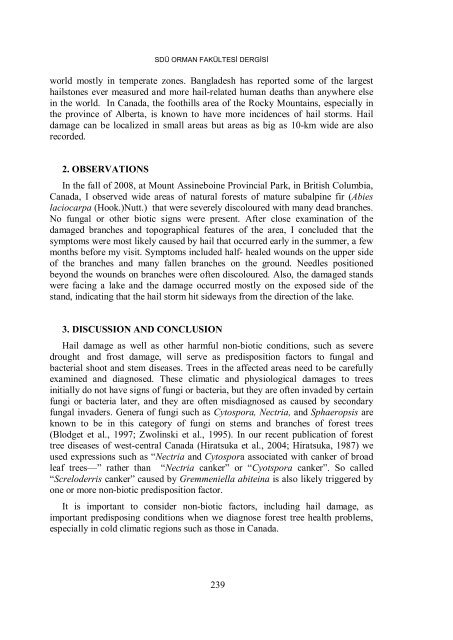sdu faculty of forestry journal special edition 2009 - Orman Fakültesi
sdu faculty of forestry journal special edition 2009 - Orman Fakültesi
sdu faculty of forestry journal special edition 2009 - Orman Fakültesi
You also want an ePaper? Increase the reach of your titles
YUMPU automatically turns print PDFs into web optimized ePapers that Google loves.
SDÜ ORMAN FAKÜLTESİ DERGİSİ<br />
world mostly in temperate zones. Bangladesh has reported some <strong>of</strong> the largest<br />
hailstones ever measured and more hail-related human deaths than anywhere else<br />
in the world. In Canada, the foothills area <strong>of</strong> the Rocky Mountains, e<strong>special</strong>ly in<br />
the province <strong>of</strong> Alberta, is known to have more incidences <strong>of</strong> hail storms. Hail<br />
damage can be localized in small areas but areas as big as 10-km wide are also<br />
recorded.<br />
2. OBSERVATIONS<br />
In the fall <strong>of</strong> 2008, at Mount Assineboine Provincial Park, in British Columbia,<br />
Canada, I observed wide areas <strong>of</strong> natural forests <strong>of</strong> mature subalpine fir (Abies<br />
laciocarpa (Hook.)Nutt.) that were severely discoloured with many dead branches.<br />
No fungal or other biotic signs were present. After close examination <strong>of</strong> the<br />
damaged branches and topographical features <strong>of</strong> the area, I concluded that the<br />
symptoms were most likely caused by hail that occurred early in the summer, a few<br />
months before my visit. Symptoms included half- healed wounds on the upper side<br />
<strong>of</strong> the branches and many fallen branches on the ground. Needles positioned<br />
beyond the wounds on branches were <strong>of</strong>ten discoloured. Also, the damaged stands<br />
were facing a lake and the damage occurred mostly on the exposed side <strong>of</strong> the<br />
stand, indicating that the hail storm hit sideways from the direction <strong>of</strong> the lake.<br />
3. DISCUSSION AND CONCLUSION<br />
Hail damage as well as other harmful non-biotic conditions, such as severe<br />
drought and frost damage, will serve as predisposition factors to fungal and<br />
bacterial shoot and stem diseases. Trees in the affected areas need to be carefully<br />
examined and diagnosed. These climatic and physiological damages to trees<br />
initially do not have signs <strong>of</strong> fungi or bacteria, but they are <strong>of</strong>ten invaded by certain<br />
fungi or bacteria later, and they are <strong>of</strong>ten misdiagnosed as caused by secondary<br />
fungal invaders. Genera <strong>of</strong> fungi such as Cytospora, Nectria, and Sphaeropsis are<br />
known to be in this category <strong>of</strong> fungi on stems and branches <strong>of</strong> forest trees<br />
(Blodget et al., 1997; Zwolinski et al., 1995). In our recent publication <strong>of</strong> forest<br />
tree diseases <strong>of</strong> west-central Canada (Hiratsuka et al., 2004; Hiratsuka, 1987) we<br />
used expressions such as “Nectria and Cytospora associated with canker <strong>of</strong> broad<br />
leaf trees—” rather than “Nectria canker” or “Cyotspora canker”. So called<br />
“Screloderris canker” caused by Gremmeniella abiteina is also likely triggered by<br />
one or more non-biotic predisposition factor.<br />
It is important to consider non-biotic factors, including hail damage, as<br />
important predisposing conditions when we diagnose forest tree health problems,<br />
e<strong>special</strong>ly in cold climatic regions such as those in Canada.<br />
239








